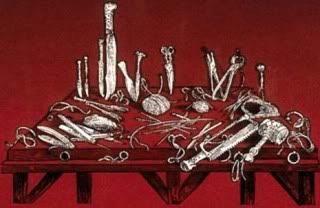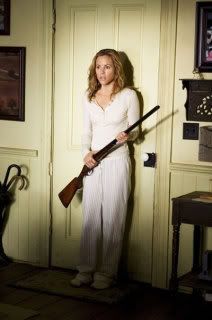While we question the reality of a situation we must also question who a person really is in a Cronenberg film. There are a wide variety of ways that the identity of a Cronenberg character comes under speculation. In films such as Shivers, Rabid and The Fly, it is disease or metamorphosis of some kind that causes a drastic change in identity. In Videodrome, The Dead Zone, Naked Lunch and M. Butterfly, it is a deliberate act by a character masking their true self that causes confusion.
Cronenberg takes this a step further in his truly unique and fascinating use of actors to really make his audience unsure as to who is who. In Naked Lunch, eXistenZ and Spider, certain actors play multiple characters to increase as well as confuse the layers of meaning to what is happening. This is especially powerful in Spider when the same actress portrays Spider’s mother as well as the prostitute he imagines his father having an affair with and the woman who runs the transitional home he lives in as an adult. "It’s very hard at this point to know what’s real and what’s not…the audience’s confusion is also Spider’s confusion.”(Spider Com. 35:06)
In exploring David Cronenberg’s films, it is essential to not only look at specific themes but to also address the overall atmosphere of feeling that they create. Extreme violence and destruction play a central role in these movies with the vast majority ending in death, often in the form of suicide. What is interesting is how this element has really evolved over the span of Cronenberg’s career, from chaos to deliberate and sophisticated subtlety.
Beginning with Shivers and on through Cronenberg’s first few films, the violence and death is frenzied, messy and loud. As character development becomes more central along with performance, death and destruction takes on a sad quality, as successfully executed for the first time in The Fly. “…I’m an insect who dreamt he was a man and loved it, but now the dream is over and the insect is awake.”(1.17:58) As Seth Brundle utters this haunting line, the tragedy of what is happening to him becomes real to us through his articulation. The audience is able to recognize that what’s really going on is incredible loss, loss of life and loss of love. When he is shot by his lover, she is not defeating a monster but ending the misery and suffering of what used to be the man she loved.
Starting with Cronenberg’s next film Dead Ringers, this element of sadness intensifies and takes on a sweet and beautiful tone through the music and cinematography which stands in contrast to the violence of the situation. It is absolutely heart-wrenching to see Beverly’s reaction to the sight of his dead brother at the conclusion of the film even though the audience knows Elliot died at Beverly’s hand. The utter sorrow and devastation comes across through the childlike whimperings of Beverly combined with the visual beauty of the scene. “It has to do with that element of being human. It has to do with this ineffable sadness that is an element of human existence.”(Cronenberg 149)

This theme of sorrowful violence progresses and intensifies through M. Butterfly, Crash and Spider. Once again, Spider proves to be an especially potent and striking example. From beginning to end, this film feels desolate, cold and melancholy but is contrasted by the absolute visual and audible beauty presented to the audience. “For Cronenberg it is an austere record of a poor human’s sad, quiet condition of suffering…a massive force pressing inwards on Spider and compressing everything into a state of dense unceasing pain.”(Beard 473) For us, the audience, the end comes as a devastating catharsis as our confusion is finally cleared but at a dismal cost.
David Cronenberg’s most recent film, A History of Violence, on the surface may seem to be evidence that he has finally crossed over into mainstream Hollywood with a straightforward gangster film. While it may come across in this fashion upon a single viewing as a stand-alone film, this conclusion would be a mistake as this study will show upon closer examination.
As the crux of this writing is looking at David Cronenberg as an auteur, we must approach A History of Violence from an auteurist standpoint. In other words, we have no basis for judgement unless we look at it as it compares and fits with the body of work as a whole. With this in mind, of the themes discussed, which ones if any, appear in History? Does this film successfully contribute to Cronenberg’s status as an auteur or does it break away from the common themes and concerns as addressed in his earlier work?
A History of Violence is the story of a man who at first is shown as a quiet, loving family man in a small, idyllic town somewhere in the Midwest. We soon come to realize that Tom Stall is not who we think he is when he is forced to kill two men who come into the diner he owns. There is something dark hidden in his past that is forced to the surface. This element certainly fits in with idea that people are not who we think they are. The Tom Stall persona is an invention, a new identity created by former gangster, Joey Cusack.
As Tom Stall’s past is uncovered, the audience witnesses his subtle regression back into his former self. Actor Viggo Mortensen displays an acutely controlled performance through the slightest variations in facial expression and linguistic style to let us know that there is something dark and deadly under the façade of this small town man. In this skilled portrayal, Mortensen perfectly illustrates how Cronenberg has evolved, refining his ability to use strength of performance to explore a common theme in a fashion that carries much more potency.
In History, we can extend the concept of a ‘body-consciousness’ to encompass the idea of the human condition and the threat certain elements thereof pose to our mortality bringing us back to our fear of death. Cronenberg discusses in an interview that while violence is something that is very common in the world we live in, we try to turn away from the reality of it happening to us. From his own perspective as a director, he says, “…artistically you feel it’s something you have to come to terms with and hope that you’ll deal with it in your creative life and not have to deal with it in your actual day to day life.”(Acts 10:28) The characters in the film must confront devastating evils while the audience keeps it safely on the glowing screen.

The violence and death in History turns away from the progression of poetic beauty found in Cronenberg’s later films and returns to the gritty, explosive destruction found earlier in his career. As this particular film finally deals explicitly with violence itself, Cronenberg was very specific in what he wanted the audience to contend with, pointing out that “…it’s all very physical human violence and it does very bad things to the human body…the audience finds themselves looking at something particularly disturbing” because “if you’re going to like the violence then you have to accept the consequences…”(History Com. 24:41) We are shown up close what it looks like when a man is shot in the face; there is no beauty in the violence here. He uses graphic realism to force us to acknowledge what really happens outside of the cinema.
It can be concluded that David Cronenberg is in fact a true auteur as the term is used in American auteur criticism. He has many common themes that he continues to return to, building and progressing the discussion in each film he makes which according to Cronenberg’s own admission, reflect his personal concerns and interests. Actor Martin Sheen recognized this when he worked with the director on The Dead Zone, recalling, “I knew here was a filmmaker with a definite point-of-view, who was courageous about it and confident enough to trust in it.”(Lucas 27) As an auteur, Cronenberg has uncompromisingly insisted on communicating this point-of-view through his work over the span of more than three decades and continues to do so today. What will he show us next?





No comments:
Post a Comment